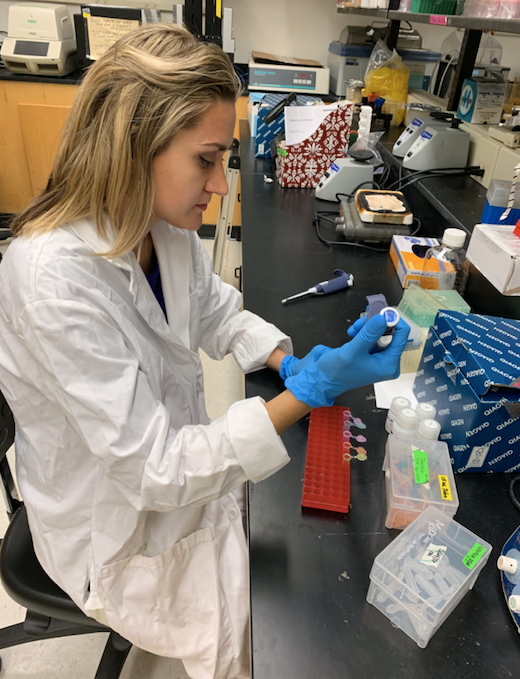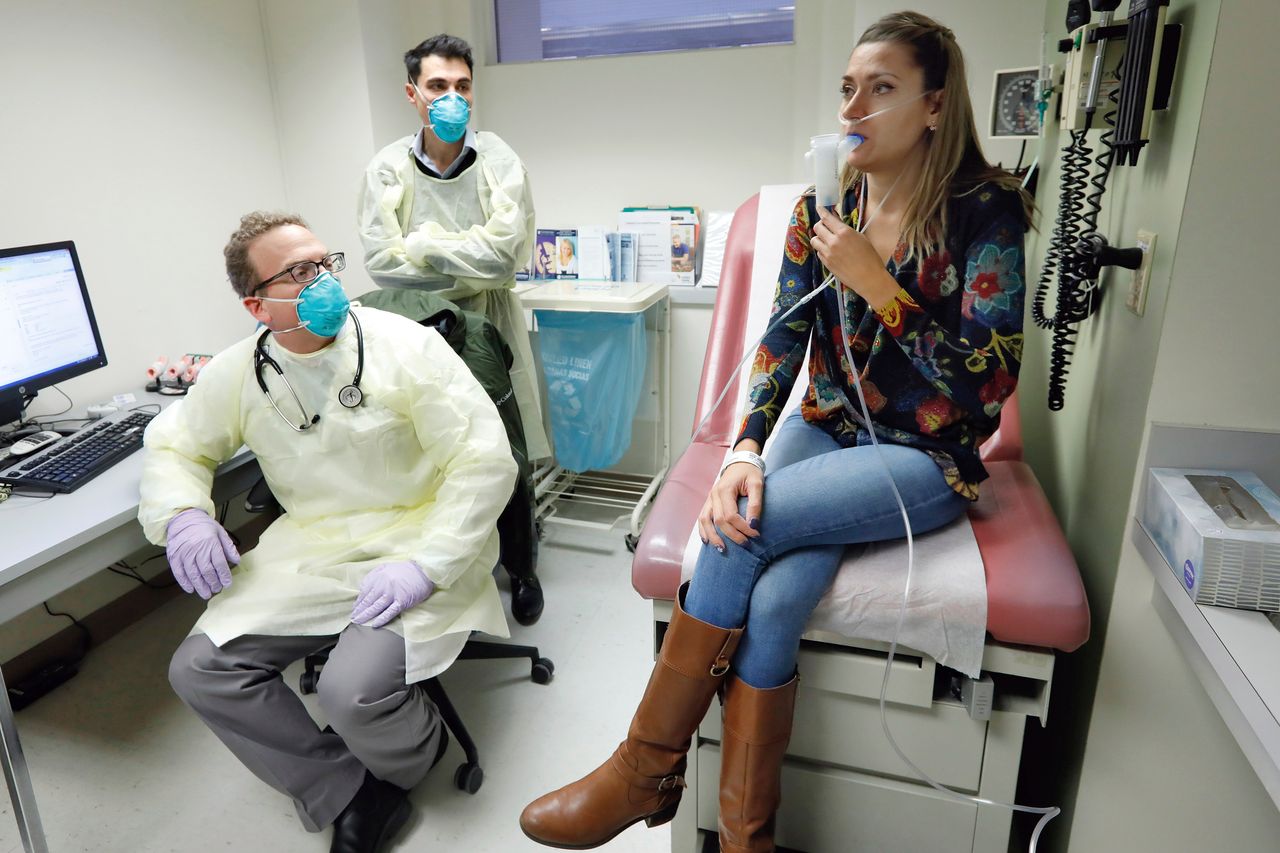The bouts of night sweats and the fatigue from the coughing fits that left me breathless over the prior few weeks were nothing compared to the sympathetic nervous system response I was experiencing that day.
I anxiously waited while cameras were set up for my interview. I had already hauled my exhausted body and my portable oxygen concentrator down several long corridors to get to the clinic. Then, sitting on an examination table and appearing stoic to any casual observer but actually utterly terrified as thoughts of horrible side effects swam in my mind, I inhaled my first dose of phage therapy.
I’m the woman that’s been at the center of some recent headline news involving the resurgence of phage therapy, which is the use of a specialized virus to kill very specific antibiotic-resistant bacterial strains. Thanks to my highly publicized experience, I now receive social media messages from strangers asking, “Well, how do you feel?” I don’t have a simple answer for them.
I’ve had a bacteria called Pseudomonas aeruginosa festering in my lungs for as long as I can remember. I was born with cystic fibrosis, which is a genetic disease that causes a buildup of thick, sticky mucus primarily in the lungs, but it also affects my digestive tract and sinuses. This sticky mucus gets trapped and breeds infections from bacteria I inhale. Over time, a cycle of infections and the concurrent inflammation from the immune system’s response causes permanent lung damage and can shorten the life span of a person with my disease.
Over the past few years, these infections have become more frequent, so much so that it’s gotten to a point where I require oral antibiotics almost constantly, as well as higher doses of antibiotics delivered intravenously three or more times a year. Yet, the antibiotics’ ability to kill off the bacteria is waning.
“A few short months after learning about phages, I became very sick with the worst infection I’d ever had. ... My lung function was at just 18%. I needed oxygen pumped into my nostrils at all times to breathe ― even when I was in the shower, because reaching up over my head to wash my hair was too strenuous for me.”
Antibiotic-resistant bacterial infections are a rapidly growing public health concern around the world, and the lack of new treatment options heightens the issue ― especially in the CF population, where individuals are especially susceptible to them. This dependence on antibiotics, and knowing at some point in the near future they will no longer clear my infections, has had me anxiously awaiting the availability of new treatments currently in clinical trials. But when I learned about phages ― including their use in the 1920s and ’30s, their continued use in Russia, a phage treatment center that’s active in the nation of Georgia, research conducted at the University of California, San Diego, and a few success cases from Yale ― I felt I had little to lose by trying the therapy, and potentially a lot to gain.
Growing up, I was terrified of doctors ― and of sharing my thoughts and opinions and of trying new things. But as I’ve matured into adulthood, I’ve found my voice and gained the confidence to discuss and make decisions about important aspects of my care with my health care professionals. So, after raising the possibility of phage treatment with my doctor, I wasn’t particularly deterred by his response, which initially was unfamiliarity with the science behind the treatment and then a wariness about the lack of data related to it.
As a patient equipped with a deeper-than-average scientific knowledge about treatments and my disease prognosis ― I am a microbiology lab manager ― I felt compelled and comfortable to pursue a treatment that I might have otherwise shied away from or never even come to learn about. It’s a vital aspect of being a receiver of health care ― asking questions, probing for answers, and gaining the knowledge to feel empowered to take an active role in shaping your health journey. (Of course, I’m not arguing that anyone should disregard their doctor’s recommendations or that trying any old backyard concoction is a good idea. Do your research and have lots of conversations with your health care professional!)
In January of this year, a few short months after learning about phages, I became very sick with the worst infection I’d ever had. I was battling a severe flare-up, even after having been on intravenous colistin, one of the strongest antibiotics available, for five weeks. I was using constant supplemental oxygen, I had frequent fevers, mucus perpetually lined all of my airways, and my lung function was at just 18%. I needed oxygen pumped into my nostrils at all times to breathe ― even when I was in the shower, because reaching up over my head to wash my hair was too strenuous for me.

I was set to begin phage treatment around this time, and in the days leading up to my first appointment I was anxiety-ridden because I didn’t know if I would be able to make the eight-hour road trip to New Haven to receive the treatment. I was terrified that my immune system was too burdened and that I would be so vulnerable that virtually anything ― from an allergic reaction to severe lung bleeding ― could go wrong. But my antibiotics had stopped working and I desperately needed to try something different.
News stories and social media posts can only capture bits of the whole truth in any situation, and there are plenty of misconceptions to debunk about phage treatment. People seem to think it’s either a miracle or that it’s some non-Western ― and therefore suspicious at best ― therapy.
Phages work best when used in combination with antibiotics because the bacteria that aren’t immediately killed by the phage are then forced to give up their resistances to antibiotics, which makes them vulnerable again to the antibiotic attacking them. I was on antibiotics at the time of my phage treatment but felt no improvement several days after starting.
It seemed that sitting on that clinic examination table with sweat soaking my armpits and my fingers clenched in anticipation had been totally unnecessary, because the experience appeared to have been entirely uneventful. However, about a week later, I started using a different cocktail of antibiotics, and within two days I was expelling all of the dead bacteria from my lungs. I had never cleared an infection so quickly before and I had used these antibiotics many times in the past, so I knew it couldn’t have just been the drugs doing their job.
Knowing the extent of infection I had ― as well as the advanced lung disease and low lung function I suffer from ― I definitely consider phages to have been successful in helping to clear my infection.
“I had never cleared an infection so quickly before and I had used these antibiotics many times in the past, so I knew it couldn’t have just been the drugs doing their job.”
With that said, phage therapy certainly isn’t a magic cure-all that will permanently rid a person with CF of infections. That’s because there are multiple kinds of bacteria living in the lungs and phages only have the ability to target a few. It can also be difficult to deposit phages deep into the smaller airways because those are often blocked by mucus, which inhibits anything from passing through. It can be even more difficult in lungs that are severely damaged like mine.
What’s more, different bacterial strains can live in different lobes of the lungs, so treatment for a particular strain in one lobe may have no effect on those in another. For these reasons, many bacteria still survive in those smaller airways, and over time, they have the ability to take over the lungs all over again.
Phages also didn’t help to improve my lung function, but I didn’t necessarily expect them to. So it didn’t change the fact that I still require supplemental oxygen for even a casual walk. After all, they are only used to kill specific bacteria and can’t rebuild damaged lung tissue ― and for someone with the extent of lung damage that I have, even after infections are cleared, the lung damage remains.
For patients who are only fighting one kind of bacterial infection, like the man whose post-heart surgery infection was treated at Yale or younger children with CF who have only recently contracted a pathogenic bacterial infection in their lungs, phages are much more likely to be able to completely eradicate their bacteria than with someone like me, who has 20 years’ worth of bacterial colonies currently thriving in my lungs.

So far, I haven’t had to use any antibiotics for over six weeks and I’m still going strong. How long will my antibiotic-free streak last? Who knows? But the more time that passes, the more I consider phage therapy to be a viable alternative or an additional option to traditional antibiotics. Of course, there are plenty of hurdles to overcome before drug manufacturers can and will begin producing phages as medication. What’s more, each patient may require a unique combination of phages based on the bacteria they harbor, and they may also require various phage combinations through the course of treatment. But these are not reasons to dismiss the use of phages ― especially with the growing rate of antibiotic resistances.
I really don’t know how long it would have taken me to fight off my infection without phages, or if I would have even been able to. I don’t want to think about the worst-case scenario ― death. And beyond the physical relief that phages have helped to provide, I’m also much more knowledgeable about my own body, my health and the new and upcoming treatments that may be possible in the future. Finally, I wanted to share my experience with phage therapy because so many people have never heard of it, and I believe that even if one person benefits from my story, it is worth telling.
Ella Balasa is a person with cystic fibrosis, a writer, an advocate and a scientist. She was diagnosed with CF at 1 year old and currently lives with 22% lung function. She graduated from Virginia Commonwealth University and works as a microbiology lab manager at the university. She is involved in the CF community through being a director of the U.S. Adult CF Association, serving on various research committees, and through her passion for writing her column at CF News Today, as well as contributing to the Cystic Fibrosis Foundation blog. When she is not working, writing or taking care of her health, she enjoys cooking, drawing, spending time with friends, and traveling as much as she can. Follow her on Instagram by heading here.
Do you have a compelling personal story you’d like to see published on HuffPost? Find out what we’re looking for here and send us a pitch!
